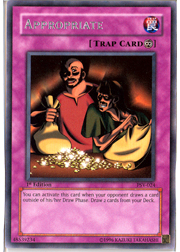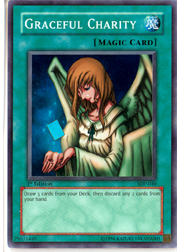
 Appropriate is one of those cards that seems intent on confusing as many players and judges as possible. It has a very specific timing window that requires patience and knowledge to conquer, but can be very rewarding after you’ve activated it. Its close cousin, Forced Requisition, is guilty of its own share of treachery.
Appropriate is one of those cards that seems intent on confusing as many players and judges as possible. It has a very specific timing window that requires patience and knowledge to conquer, but can be very rewarding after you’ve activated it. Its close cousin, Forced Requisition, is guilty of its own share of treachery.
This week belongs to Appropriate. With recent releases like Destiny Hero - Defender—a card you will see works quite well with Appropriate—it’s a good time to introduce this classic card to our new players and also provide a refresher for us old timers.
One for You, Two for Me
For this article, we will refer to the most recent text for Appropriate found on the official Yu-Gi-Oh! TCG Card Errata page:
“You can activate this card when your opponent draws a card outside of his/her Draw Phase. After that, each time your opponent draws cards outside of his/her Draw Phase, you draw 2 cards.”
The intended result of this card is quite clear. We intend to use Appropriate’s effect to draw two cards every time our opponent draws a card (or cards) outside of his or her draw phase. The most difficult part of the equation is the activation itself, and you can expect that this portion will confuse newer players who have not been exposed to such strict timing requirements.
Appropriate has an effect trigger that cannot be satisfied until your opponent draws a card (or cards) outside of his or her draw phase. When this action occurs, Appropriate needs to activate immediately, but that is not always possible. If a card’s effect still has more actions to carry out, or if the chain hasn’t completely finished resolving, you miss your chance to activate Appropriate. This is often referred to as “missing the timing.”
Activating Appropriate—the act of flipping it face up—is normally the beginning of a brand new chain because of these strict timing restrictions. In order to truly understand the difficulty of this, we will need to examine some examples.
 We begin with Pot of Greed. Its effect is the very simple act of drawing two cards from your deck. Suppose your opponent activates Pot of Greed during his or her first main phase and you have a set Appropriate. When will you activate your Appropriate?
We begin with Pot of Greed. Its effect is the very simple act of drawing two cards from your deck. Suppose your opponent activates Pot of Greed during his or her first main phase and you have a set Appropriate. When will you activate your Appropriate?
The text for Appropriate says that you cannot activate it until your opponent draws card(s) outside of his or her Draw Phase. Now, that hasn’t actually happened yet. At this point your opponent has only activated a spell card and has not yet drawn any cards from its effect. They will not draw two cards until the effect resolves, so it is not possible to activate Appropriate yet. We must wait until our opponent has resolved the Pot of Greed. Your opponent draws two cards outside of his or her draw phase when they resolve Pot of Greed, but does nothing else afterwards. The chain is complete and no other effects resolve after he or she draws the two cards, so the time is perfect to activate our set Appropriate.
In this situation you could replace Pot of Greed with Jar of Greed and achieve the same result. Both cards’ effects are only a simple act of card drawing. We won’t be able to fully grasp Appropriate by sticking to such simple cards, so let’s complicate things a bit.
Pot of Avarice has a lot more going on. This cards demands that you return five monsters in your graveyard to your deck, shuffle your deck, and then draw two cards. Do these extra actions prevent us from activating Appropriate?
Consider the order of the effects when they are resolved: take the selected five monsters from your graveyard and add them to your deck, perform the necessary shuffle, and, finally, draw two cards. If our opponent uses Pot of Avarice, what is the very last action he or she will perform when resolving the effect? He or she draws two cards, just like Pot of Greed. Since no actions in the effect occur after drawing two cards, you will be able to begin a new chain by activating your set Appropriate.
Your opponent’s card effect need not always be the one responsible for his or her drawing a card outside of his or her draw phase. If you use a card that accomplishes the same task, the timing can be met for Appropriate. This is where a card like Destiny Hero - Defender comes in handy.
While Destiny Hero - Defender is face up on your side of the field, its effect allows your opponent to draw one card from his or her deck during his or her standby phase. Normally this situation isn’t very helpful, but Appropriate can allow you to work around this. I mentioned this combination in my previous article on the Destiny Heroes, but this time let’s take a more detailed look.
The combo begins with Destiny Hero - Defender. Its effect activates in your opponent’s standby phase, beginning a chain. When the chain resolves, your opponent will draw one card from his or her deck. The act of the drawing is the last thing to resolve in the chain and, when it does, the chain is finished. This gives us the perfect opportunity to activate (flip face up) our Appropriate, beginning a new chain.
 Now that we have covered examples of what does work, it’s only fitting that we look at what does not work.
Now that we have covered examples of what does work, it’s only fitting that we look at what does not work.
Graceful Charity often becomes embroiled in discussions of Appropriate. Those unfamiliar with how Appropriate activates will question whether Graceful Charity is a fair trigger for its activation. The answer to this riddle is deciphered in the same manner that Pot of Avarice and Destiny Hero - Defender were deciphered.
When your opponent resolves Graceful Charity, he or she performs two actions: draw three cards from his or her deck and then discard any two cards from his or her hand. The final action is important because it will be used to determine whether we can or cannot activate Appropriate.
Using what we’ve learned thus far, can we activate Appropriate? Our opponent’s final action when resolving Graceful Charity is the discarding of two cards from his or her hand. This act prevents us from activating our Appropriate because the proper trigger—the opponent drawing cards outside the draw phase—is not the most recent action.
The act of “missing the timing” most often occurs because a required effect resolved during the resolution of a chain and not as the final effect of the chain. This can hinder some pretty useful effects, and Appropriate can fall prey just as easily. If an effect that normally works well for Appropriate (like Jar of Greed) occurs as one of the higher links of a chain, it will not be in the right position when the chain is resolved and will thus not be able to satisfy Appropriate.
The use of Disturbance Strategy inadvertently results in this kind of situation. Normally you would begin a chain with Disturbance Strategy so that its effect’s resolution will be the last effect on the chain and thus satisfy the timing for Appropriate. But this can go awry if you find yourself forced to activate it as a later link in the chain due to the actions of your opponent.
Most of the commonly played card-drawing effects function at the lowest spell speed and thus work in most cases . . . unless the damage step is involved. That’s when things can become quite complicated. Next week we will continue our discussion of Appropriate with “the wait state” it establishes and detail how it interacts with cards in the damage step. Don’t miss out!
Until then, send all comments and questions to Curtis@metagame.com